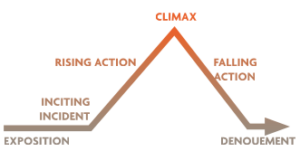How to Judge Prose
Basic Understanding
Prose is an event in which students will use a short story, parts of a novel, or other published works of prose to construct a speech. Prose combines multiple elements of oral interpretation of literature. Prose corresponds to usual patterns of speech—that which you would find most every day in a particular space and time (in contrast to poetic form and language). Prose typically has a narrative with its related rises and falls, character development and dialogue, and often has humorous elements embedded. Students may not use poetry, nor drama (plays), in this category. Students must use a manuscript in Prose, which typically consists of a small three-ring binder with page protectors.
The time limits for Prose varies from state to state, so make sure to check on the time limit used at the tournament you are judging. For NSDA tournaments, high school students have 5 minutes with a 30 second grace period; middle school students have 7 minutes with a 30 second grace period.
Evaluating the Round
When judging all Interpretation events, it is helpful to keep the Dramatic Structure in mind.

Exposition sets the scene and gives background information. Exposition occurs throughout the cutting and enhances the audience’s understanding of what the characters in the program are experiencing. The Inciting Incident sets a conflict into motion and represents the beginning of the Rising Action, which complicates the plot. The Climax is the point of greatest intensity and the turning point of the plot. Falling Action resolves the conflict and Denouement gives a glimpse of life after the conflict. Are you able to follow the plot of the piece? Is the theme or narrative effectively conveyed? Does the selection flow well and make sense in terms of how it’s developed?
Consider the performer’s blocking. Blocking, or the movements a performer makes to convey space, emotion, and action, should enhance the performance, not distract from the story. Movements should be motivated by either internal or external factors. Internal motivation stems from how the character is feeling, while external motivation comes from a physical reaction to external factors. In Prose, the student is allowed to use the manuscript as a prop to enhance blocking as long as they maintain control of the manuscript at all times. Ask yourself: Does the presenter’s use of physicality, facial expression, and gestures enhance the performance? Does the overall blocking contribute to the interpretation of the material? Does the speaker avoid distracting and unmotivated movement? Is the presenter comfortable and commanding of their space?
Characterization reveals the personality of the character through line delivery, vocal, and facial expression, and varying levels of levity and intensity. Consider whether the speaker clearly distinguishes each of the characters in the selection. Are the character(s) and their attitudes clear? Does the presenter’s use of vocal qualities like diction, pausing, and volume advance the narrative?
Filling Out the Ballot
Performers are ranked compared to the other students in their room with the best performance receiving the one ranking. The judge may also be asked to assign speaker points, typically in a range from 90 and 100, with 100 being outstanding.
Each performance has a time limit with a 30-second grace period. If a performance exceeds the grace period, the student cannot be ranked first. There is no other prescribed penalty.
The judge will also write comments to the performers on the ballot addressing different areas of the performance. When critiquing a program, judges ought to reference areas of the Dramatic Structure that were strong or weak and suggest ways in which the student can improve upon the cutting. Judges should consider if there were particular parts of the performance where it was difficult to follow the narrative. If the performer’s blocking is ineffective, the judge ought to indicate ways the performer can improve on the ballot. Critiquing characterization requires the judge to consider whether the character’s response to a situation is believable. The ultimate goal of blocking, programming, and characterization is to create a fully realized performance that moves the audience. The performer who combines these three factors the best should receive the one ranking.
